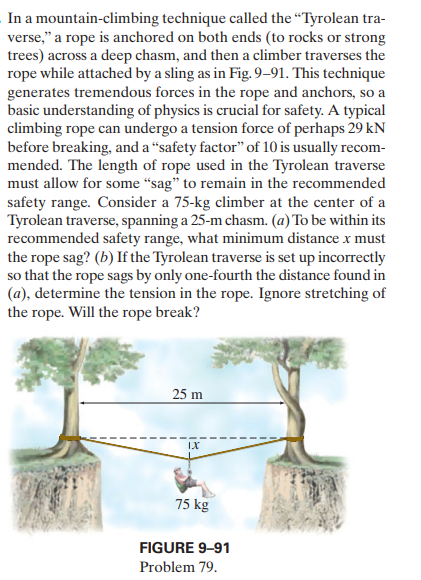In a mountain-climbing technique called the "Tyrolean tra- verse," a rope is anchored on both ends (to rocks or strong trees) across a deep chasm, and then a climber traverses the rope while attached by a sling as in Fig. 9–91. This technique generates tremendous forces in the rope and anchors, so a basic understanding of physics is crucial for safety. A typical climbing rope can undergo a tension force of perhaps 29 kN before breaking, and a “safety factor" of 10 is usually recom- mended. The length of rope used in the Tyrolean traverse must allow for some “sag" to remain in the recommended safety range. Consider a 75-kg climber at the center of a Tyrolean traverse, spanning a 25-m chasm. (a) To be within its recommended safety range, what minimum distance x must the rope sag? (b) If the Tyrolean traverse is set up incorrectly so that the rope sags by only one-fourth the distance found in (a), determine the tension in the rope. Ignore stretching of the rope. Will the rope break? 25 m IX 75 kg FIGURE 9-91 Problem 79.
In a mountain-climbing technique called the "Tyrolean tra- verse," a rope is anchored on both ends (to rocks or strong trees) across a deep chasm, and then a climber traverses the rope while attached by a sling as in Fig. 9–91. This technique generates tremendous forces in the rope and anchors, so a basic understanding of physics is crucial for safety. A typical climbing rope can undergo a tension force of perhaps 29 kN before breaking, and a “safety factor" of 10 is usually recom- mended. The length of rope used in the Tyrolean traverse must allow for some “sag" to remain in the recommended safety range. Consider a 75-kg climber at the center of a Tyrolean traverse, spanning a 25-m chasm. (a) To be within its recommended safety range, what minimum distance x must the rope sag? (b) If the Tyrolean traverse is set up incorrectly so that the rope sags by only one-fourth the distance found in (a), determine the tension in the rope. Ignore stretching of the rope. Will the rope break? 25 m IX 75 kg FIGURE 9-91 Problem 79.
University Physics Volume 1
18th Edition
ISBN:9781938168277
Author:William Moebs, Samuel J. Ling, Jeff Sanny
Publisher:William Moebs, Samuel J. Ling, Jeff Sanny
Chapter12: Static Equilibrium And Elasticity
Section: Chapter Questions
Problem 13CQ: Note: Unless stated otherwise, the weights of the wires, rods, and other elements are assumed to be...
Related questions
Question

Transcribed Image Text:In a mountain-climbing technique called the "Tyrolean tra-
verse," a rope is anchored on both ends (to rocks or strong
trees) across a deep chasm, and then a climber traverses the
rope while attached by a sling as in Fig. 9–91. This technique
generates tremendous forces in the rope and anchors, so a
basic understanding of physics is crucial for safety. A typical
climbing rope can undergo a tension force of perhaps 29 kN
before breaking, and a “safety factor" of 10 is usually recom-
mended. The length of rope used in the Tyrolean traverse
must allow for some “sag" to remain in the recommended
safety range. Consider a 75-kg climber at the center of a
Tyrolean traverse, spanning a 25-m chasm. (a) To be within its
recommended safety range, what minimum distance x must
the rope sag? (b) If the Tyrolean traverse is set up incorrectly
so that the rope sags by only one-fourth the distance found in
(a), determine the tension in the rope. Ignore stretching of
the rope. Will the rope break?
25 m
IX
75 kg
FIGURE 9-91
Problem 79.
Expert Solution
This question has been solved!
Explore an expertly crafted, step-by-step solution for a thorough understanding of key concepts.
This is a popular solution!
Trending now
This is a popular solution!
Step by step
Solved in 2 steps with 2 images

Recommended textbooks for you

University Physics Volume 1
Physics
ISBN:
9781938168277
Author:
William Moebs, Samuel J. Ling, Jeff Sanny
Publisher:
OpenStax - Rice University

University Physics Volume 1
Physics
ISBN:
9781938168277
Author:
William Moebs, Samuel J. Ling, Jeff Sanny
Publisher:
OpenStax - Rice University